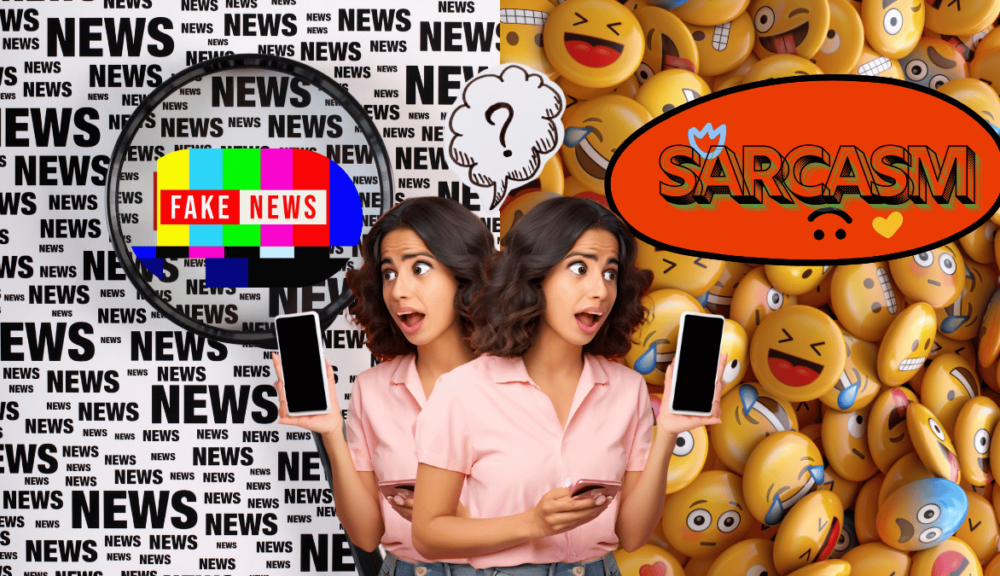Entertainment
Is all AI News Fake on Social Media? The Lies and the Sarcasm
Social media contains everything from fake to sarcastic news. How can we see through the blur between real and unreal?

Every morning, we scroll through our social media feeds, and this has become as important as sipping our first cup of coffee or chai. We developed this ritual and passed it on to the next generation for a daily dose of information, news, and gossip. But have you ever wondered if everything you see is true?
Social media is a massive digital bazaar where truth and lies sit side by side, often dressed as twins in the same glitzy clothes. The rapid growth of Artificial Intelligence (AI) made this harder than ever. AI might build self-driving cars and chatbots, but in India, it’s crafting fake stories, edited videos and morphed images that look and feel as real as the news you see on TV.
A global survey by Hosting Advice revealed that 58% of people were tricked by AI-generated fake news or at least realised that they had been. This isn’t surprising. AI has reached a level where it can generate such realistic content that you will fall victim for the sake of your favourite stars, politicians and influencers.
Why Do We Fall for AI Fake News?
We are humans and we trust what we see. Our brains process images faster than words, making visual content even more convincing. Isn’t it obvious we have reels going so viral?
Think about it. One AI-generated deepfake video or an article with random stuff and misinformation about anything will spread like wildfire. The more we see something like this on our feed, the more believable it seems. That’s the dangerous power of fake news amplified by AI. Only when it is promoted and published as a genuine one, right?
Not All Fake News is Sinister

While AI-generated fake news spreads harmful intentions and lies for profit or political gain, there’s always another side to the coin. Satirical news channels mushroomed as an alternative. These channels use humour in their news to make us laugh and think.
Let’s take The Fauxy, one of India’s first satirical websites, referred to as “India’s answer to The Onion.” This sarcastic news organisation was launched in 2018 by Vinay Sharma, a Gurgaon-based platform that spurs satire of current events, entertainment and public figures. Fauxy’s humorous takes have sometimes been mistaken for real news, proving how good satire can mimic the real thing. They have over 150K followers on Instagram.
Then there’s The Tathya, a modern, Gen-Z-inspired social media channel offering “unwanted truths” in all hilarious ways possible. With 64.3K followers and over 10 million views, their posts are pure satire, creative, funny and out-of-this-world. They’ve built a unique multiverse of sarcastic news people love escaping into.
Another Karnataka regional channel, Nin.noun is a sarcastic news account. It all began just for fun and when he had around 2K followers, their content gained attention. However, they received complaints about inconsistent posting. Noticing how much people enjoyed and missed their updates, Nin.noun decided to take on the challenge. What started as a 29-day challenge to post sarcastic/fake news daily has turned into a growing wonder with 17.6K followers and over a million views. The creator’s goal? To bring regular, humorous content to fans who had been complaining about inconsistent updates.
There’s a thin line between satire and harm; better watch it!
Satirical news and AI fake news might look similar at first glance, but their intentions are entirely different. Satire is meant to entertain and make us think, while fake news often deceives and manipulates.
Sarcastic news influencers don’t hide their humorous intentions. But even satire can sometimes be mistaken in an AI lies flood.
The Bigger Picture
AI-generated fake news isn’t just about a few misleading headlines. It can affect our mental health, political views and even finances. The more we consume such content, the harder it becomes to tell what’s real and what’s not.
So, what can we do about it?
- Just like for every problem, education is key. Many schools and colleges in India are introducing literacy programs to teach students how to spot fake news and receive information. Some organisations are planning to introduce how to become influencer courses as most GenZ and Gen Z Alpa youth are clear about what they want to become. Watch this space for more about this. Everyone, from your younger siblings to your grandparents, must learn how to filter the information they consume.
- Just like a diamond can be cut with a diamond, a thorn can be removed by a thorn. Tech plays a significant role. Social media platforms like Instagram, Facebook and Twitter must invest more in innovative algorithms to detect and flag fake news. Fact-checking will play a significant role in helping viewers verify what they see.
- It’s not rocket science. These days, even building a bomb and rocket is available online, so learning to spot the fakes from the real isn’t a big deal.
Stay ready, not restless.
At the end of the day, the battle against fake news isn’t just about technology; it’s about people. If we learn to question, to think critically, and to laugh without losing sight of the truth what can influence you?
The next time you scroll through your feed, remember, “Not everything is what it appears. But if it makes you chuckle, it’s probably just satire. Or is it?
Check out our take on the gender divide in social media news influencers Here!
